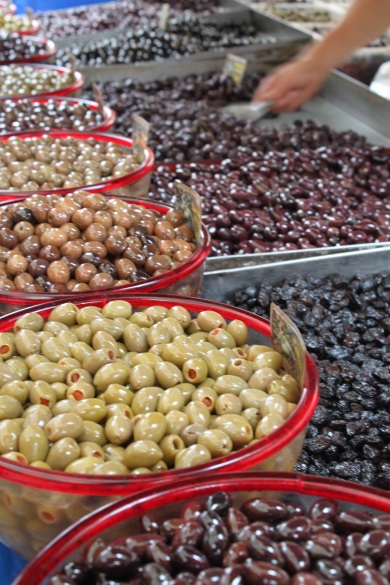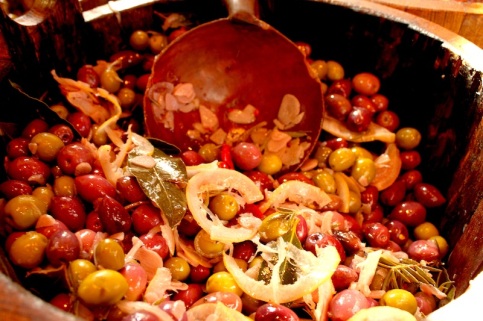
How to make your own olives edible.
Mom would say, “Only eat 8 olives a day, honey.” But it was too easy to devour the salty Grecian delights by the dozen. With crusty brown sourdough bread and green virgin olive oil on a flat side plate, nothing satisfied me more than eating Yiayia’s Kalamatas olives in the middle of Chicago’s winter. To this day, I have a plate solely dedicated to olives and their pips and snack on these pickled fruits year round (and still by the dozen).
Growing up, I’d spin the bottom shelf of the cupboard to reveal Yiayia’s hand-picked, home-cured Kalamata olives. Purple, green and maroon olives floated in one gallon glass jars of oregano, thyme, vinegar and oil. As a kid, I was powerlifting the heavy 2 gallon olive jar off the bottom shelf and onto the counter in order to dip my tiny fingers into the oil and vinegar brine to search for the juiciest olives. As I got older, I’d use an oversized spoon to fish for the tangiest Kalamatas, and strain the brine from the spoon to reveal my bite-size snacks. When May arrived, it got harder for the spoon to fish for olives at the bottom of the jar. I’d spend the whole year snacking on the cured fruits and diminished our Greek food provisions we would smuggle in from Greece. The empty olive jar was an indicator that it wouldn’t be long before we would pack our dresses and sandals for the summer at Yiayia’s house. Mom would pack a suitcase within a suitcase when we travelled to Athens. In August, we would return to Chicago with more olives to fill the jar, and enough oregano to make the beagles sniff us out as drug smugglers.
Now, when May arrives I pick 10-20 kilos of Mission Olives around Cape Town, South Africa. My childhood love for enjoying home-cured olives, fills my own cupboards with a cultural joy and salty olive treats to share in memory of my grandmother’s tradition.
Every step of the curing processes makes me wonder of when and how people discovered this ancient practice.



Was it Athena’s olive tree branch that broke off during an autumn storm? The branch that fell into the river bed and carried it for weeks into the salty estuary of Poseidon’s sea. For weeks it may have soaked along the shores until a small family fishing boat arrived near Kalamata and came across the curing olive fruit branch floating in the water. If they tasted the divine harmony of the Greek Gods’ elements and discovered that the olive fruit tree was not just best for oil, wood and shade, but for it’s fruit too, then let that be the start of a nourishing tradition.
I have been learning about the whole benefits of the olive tree itself recently when I’m not making up mythological stories of food origins. 🙂
With all its rich phytonutrients and phytochemicals (phyto stems from the Greek word-plant), the medicinal compounds from the leaves, fruit, roots and stems, play a major role in fighting bacterial and viral infections/disease as well as boosting the immune system to prevent and treat flus and colds. The olive tree’s ancient medicinal presence is found in many religious texts such as the Qu’ran, Torah and Bible, and continues to feature in Internal Medicine Journals today.
The oleuropein (the bitter substance in olives) has been founded to inactivate bacteria, and display a number of other benefits in pharmacology research. Essentially, it is an herbal powerhouse effective for infectious and chronic health conditions. I like to use olive leaf extract or make olive leaf tea as a preventive agent in my overall health. Olive leaves are now a staple in my cupboard alongside cured olives. I’ve found ways to use olive leaves in many everyday uses by sprinkling the leaves in salads, porridge, soups, and breads. Don’t be surprised if I post an Olive leaf smoothie in the near future. I promise it wont be bitter!
For now, I would like to share some delicious combinations of flavours I’ve added to my curing olives over the years.
But first, there are a variety of ways to cure olives. Check out the Australian Olive Grower Issue #4 for some inspiration.
For the past three years, I have been roughly following a water bath recipe given to me by Francolin Farm.
1. After picking your olives, place rinsed olives in a net bag (the ones you store onion’s with) and put into a bucket and cover with water. Don’t pack olives too tightly and take care not to bruise them. I place my olives in a cooler box because it has a spout I can lift open to let the water drain. Some people save water by placing the olives on top of the toilet basin where fresh water gets drained everytime you flush. Others just fill their bathtub and drain it daily. It would be nice to find some use for your greywater (olive water) in your garden.
**** If water shortage is an issue, fill your bucket with 50% salt and 50% olives. Gently turn and toss olive jars daily for 2-3 weeks. Rinse and skip to Step 4.
2. Change water once or twice daily for 2-3 weeks. Simply lift the net bag with
olives out of the bucket and pour off water and replace in fresh water. Taste after two weeks and continue if it is still too bitter.
3. Dissolve 500 grams coarse salt in 5 litres boiling water. Allow to cool.
This mixture is sufficient for approx 2 ½ kilos of olives. Leave olives in this
brine solution undisturbed for one week. Taste, if bitter replace with fresh
brine solution and leave for a further week. I like to use non-iodized salt or kosher salt. The other ratio to use is 1 part salt to 10 parts water.
4. Rinse olives several times with fresh water. Cover with brown vinegar for
24 hours. Pour off vinegar and expose the olives to air overnight or a few hours
till dry. This brings the colour of the olives back to a deep purple/black. You may notice they lightened in colour when they were soaking.
4. Pack olives gently in clean warm sterilized jars. Make a brine of 1:10 ratio of salt to water (1 TB to 1 litre of water). Optional: when brine mixture boils pour in 250 ml wine vinegar. The vinegar is not necessary, but many people love the taste of red wine vinegar instead of the rich olive taste. The art is getting all flavours to balance, in true Grecian culinary wisdom -Everything in Moderation. Pour hot brine mixture over . . . . . But wait! This is where your creative olive marinade flavours get to feature.
Let your imagination go wild. In addition to your brine (whether it is the vinegar and salt, or just 1 part salt to 10 part water ratio.) The salt ensures that the olives cure without bacteria growing and spoiling the fruit. If you notice some white film, don’t stress. You can scrape it off or leave it to add flavour as some people believe. This is lacto-fermentation happening! Before filling the jars with olives, add your favourite pinches of spice and intuitive amounts for your olives to marinate in. Then, place olives into the jar, filling the jar to the brim. Pour your salt brine over and seal jar immediately whilst the liquid is warm.

Some flavour marinades I’ve done in the past:
Smoked Chipolte Chili Powder and Rosemary
Mustard Seeds and Laurel Leaf
Greek Traditional: Lemon Juice, Lemon Rinds, Rosemary and Garlic cloves
Herbaliser: Basil, Oregano, Lemon and Thyme
Nasturtium and Peppadew
Lemongrass and Ginger
Cumin seeds, Cayenne and Lemon
Miso and Ginger
Celery Seeds, Bay Leaf and Tarragon
Sage and Rainbow Peppercorns
Acha Masala
Smoked Paprika and Lemon Slices
Lavender Flowers, Cloves and Cumin
Cardamom, Peppercorn and Cinnamon
Red curry powder and Turmeric
Carraway Seeds, Celery and Carrot


Share your olive marinades and enjoy!








Excellent Food For Thought thank you
I married my lovely Panayiotis in 1962 , and learned from him and his sister Nafsika about pickling olives and their wonderful use. Such wonderful food!
Great post! I miss the jars in the lazy Susan
I have made this recipe twice now and it’s absolutely AMAZING. I thought I’d fluked it the first time it turned out so great but then the next years crop turned out just as tasty and was a great hit with all that had a taste! Thanks so much for sharing! I’m very grateful!
I forgot my olives for a few weeks after putting in the brine. They now have little spots on them. Are they mouldy and should I throw out?
Hi Mel, taste them and see what your tastebuds say. Could the spots be before you did the brown vinegar soak?
Thanx a lot I love olives n Greece cuzin
Hi!! My olives are currently soaking in the salt water brine after 2 weeks in just water. I’m wondering about the last step after I put them in the final brine solution in jars with flavorings- after I seal the jars, do they need to sit for a specified time before eating? How soon are they ready? I am eager to try them! Thank you!
Depends how patient you are 🙂 I typically wait a month before trying, but you can taste-test after 2-3 weeks. Curing varies and each time, depending on weather, the fruit, etc the tastes will develop over time. So for example, if you let it sit for a year, the olives may even become mushy and loose their firmness. Use it for tapenade, but normally the olives won’t be sitting for that long if you leave the jar on your counter and enjoy!
So when will the olives be ready to eat? How long do you leave them after filling them with olives and brine?
Taste after a month and see how you like it!